Five Faces of Mary
Robert P. Maloney, C.M.

We know very little about the Virgin Mary, though the little we know is tantalizing. She played, of course, a crucial role in the story of Jesus and has had an enormous influence in the history of Christianity. The major creeds profess that Jesus was "conceived by the Holy Spirit and born of the Virgin Mary." Mary's impact on Christian piety has been powerful. She is the first among the saints to whom we unite our voices in prayers of praise and petition. Is there any prayer that has been said more frequently than the Hail Mary?
On the affective side, Mary has come to symbolize maternal listening for countless people, becoming for them, as a modern writer puts it, "an icon of the tenderness of God."[1] On the level of moral response, Christians, reflecting on the New Testament, regard Mary as the ideal disciple, the first among the saints.
Her influence has deeply affected art, music, and poetry. We need only to recall some of the striking paintings of the Virgin Mary, like the Madonnas of Botticelli, of Lippo Lippi, of Murillo. And of course we have all often heard wonderful Ave Marias like those of Schubert and Gounod, as well as countless other Marian hymns. Dante, Shakespeare, and many others all wrote beautiful poetic tributes to the Virgin Mary.
But perhaps nowhere has Mary flourished so much as in the popular imagination. A recent author speaks of the thousand faces of the Virgin Mary.[2] In this brief article I will present five of these faces. I encourage the reader not just to reflect on the few words that I write, but also to meditate with me on these faces. Paintings, icons, mosaics and images created within our own minds and hearts have a way of speaking that goes beyond words.
Miriam of Nazareth
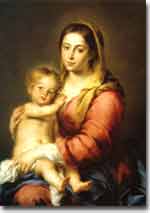
I have chosen to represent Miriam of Nazareth, the lovely "Virgin and Child" of Murillo (1617-1682). But beautiful as it is and much as I like it, I recognize that its Virgin is surely more European than the historical Miriam of Nazareth. Though we do not know what Miriam actually looked like, Murillo's painting portrays her union with her son, something which is central in the biblical texts that describe her, and the deep serenity that flowed from it.
With this first image, we reflect on the Mary of history of whom we know so tantalizingly little. Let me try to express the little that we can say historically of the Virgin Mary.
Mary was actually called Miriam, after the sister of Moses. She was born probably in Nazareth, a small village of about 1600 people, almost all of whom were Jews. If she was not born there, she at least lived much of her life there; her son came to be called "the Nazarene," as stated in the inscription placed above his head on the cross. Her birth took place most likely between 20 and 15 BC. She, Joseph, and Jesus lived in territory occupied by a foreign power, the Romans, whom many Jews hated. The atmosphere was often tense.
Her husband, Joseph, and her son, Jesus, were woodworkers.[3] The language that she and they spoke at home was Aramaic, though perhaps she also understood a little Hebrew from hearing it read in the local synagogue services. She may also have understood some Greek phrases; they would have been helpful in the woodworking business since many of the merchants at that time in that area of the Roman Empire were Greek-speaking.
Like mothers of that and many other eras, she would have breast-fed her child, cooked meals regularly, and done lots of housecleaning and washing. She would have carried water home from nearby wells or streams. Of course Mary too, like most mothers, would have taught her son to walk, to talk, to pray, and to do many other things.
Women in Palestine in that period were rarely given the opportunity to study, so it is likely that Mary did not know how to read or write. Her learning came orally through family traditions she imbibed at home and from the reading of the Scriptures, along with homilies, that she heard in the synagogue.
Mary, Joseph, and Jesus were poor, but, since Joseph had a trade, they were probably no poorer than most Galileans of their time.
Joseph seems to have died before Jesus' public ministry began. Mary herself, however, was alive throughout that ministry.[4] Her separation from Jesus as he began his ministry was probably painful for her. Mark tells us that Jesus' family thought him mad[5] and that Jesus resisted a request of his family to see him.[6] She was present at his crucifixion. At that time she would probably have been around 50 years of age herself. She lived on at least into the early days of the Church.[7]
What does this first face say to us? It says that Mary was rooted in real life. She was one of us. Like most women of her time, she was hardworking, had little formal education, and was rather poor. She was a deeply believing Jew whose faith was nourished by the word of God which she heard in the synagogue. She loved and nourished her child and her husband. She kept house. She probably helped in the carpenter shop from time to time. She may well have experienced some confusion when her son left the shop and set out on an extraordinary ministry. She must have known joy at his successes and she certainly felt anguishing sorrow when he was condemned as a criminal and put to death. All of us can identify with that kind of life. It was not easy. Nor was it very glorious. Yet it had a noble beauty about it.[8] Mary was so real that people of every age have felt that she understands their joys, their needs, their sorrows.
The Listening Disciple
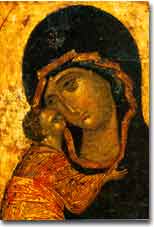
Here I have chosen a 15th century icon from Moscow called "The Mother of God of Tenderness." In this type of icon, of which there are many examples, the Mother listens attentively and sadly while the son reveals to her his passion and death. The icon captures a prominent New Testament theme.
While the modern world is very curious about history, the New Testament writers were much more interested in.
The Scriptures often give just a few basic historical facts about a person ─ not enough to satisfy our modern curiosity ─ and then focus on the meaning of that person's life for us who are believers. For the Scriptures, Mary is the ideal disciple, the model listener. She hears God's word and acts on it. This theme is most explicit in Luke's gospel. In Luke's first two chapters Mary is evangelized by Gabriel, by Elizabeth, by the shepherds, by Simeon, by Anna, and by Jesus himself. All of them proclaim the good news of God's presence and sing in praise of God's goodness. Luke tells us that Mary kept all these things in her heart, turning them over and over again.[9]
Mary's response to what she hears from Gabriel is typical: "Be it done to me according to your word."[10] Luke sums it all up in a lovely little story[11]
His mother and brothers came to be with him, but they could not reach him because of the crowd. He was told, "Your mother and your brothers are standing outside and they wish to see you." He told them in reply, "My mother and my brothers are those who listen to the word of God and act upon it."
This theme, Mary as the Listening Disciple, has often been overshadowed by other more exalted Marian titles. But it is an extremely important one. In fact, it lies at the core of New Testament spirituality: all disciples, like Mary, are called to listen to the word of God attentively and act on it.
What can we learn from this second Marian face? We can learn to listen. There is almost nothing more important that Mary can teach us. At root, being a disciple means being a hearer of the word. The whole of Christian life can be summed up in the Lucan phrase that describes Mary so aptly: "She listened to the word of God and acted on it."
The Mother of God
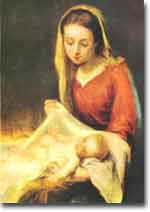
This high theological nativity scene, with its trinitarian motif, comes from an artist of the School of Bologna, which flourished in the 17th and 18th centuries. The painting reflects many themes from the infancy narratives of Matthew and Luke: God's Providence, the Spirit, the angels, Joseph's dreams, Mary's peace.
Mariology has known its ups and downs. Mark's gospel and some of the early Fathers of the Church show little interest in it. Luke and John, on the other hand, emphasize the role that Mary played in the history of salvation. But Mariology took a striking leap when, in the year 431 at the Council of Ephesus, Mary was declared "Mother of God." This is surely the most glorious of the Marian titles.
It is not, however, simply a Marian title; it was intended as a reaffirmation of Jesus' divinity. This title was a reaction to the Arians of the 4th and 5th centuries who denied the divinity of Christ. The Church responded by stating clearly: Mary is not just someone who gave birth to a deeply spiritual, human person, Jesus; rather, the Council of Ephesus affirmed: Mary gave birth to the one who is God in the flesh.
We repeat this title again and again in the Hail Mary. The icons of the Eastern Church, where this title was born and where it was proclaimed at Ephesus, depict Mary with the Divine Child in her womb or at her side blessing the world. In mosaics, we often see her beside the Risen Lord in glory. Important as this title is, it is easy to misunderstand. It has known a long history of controversy. In this ecumenical age, it is essential to recall that to proclaim Mary as the Mother of God is to profess our faith in the divinity of Jesus. In that sense, this Mariological title is profoundly Christological.
What can we learn from this third face of Mary? We can learn that her role was singular. She was the Ark of the Covenant, so to speak, the dwelling place of God. Her relationship with the person of Jesus is unrepeatable; she was his mother. He is flesh of her flesh. Yet the poor have always noted, as Mary herself sings in Luke's gospel, that God chose her from among them.[12] The New Testament and the long tradition of the Church teach us, moreover, that Mary's unique relationship with God, in her son, flows not from her physical relationship with him, but from her first conceiving him in faith. Chosen from among the poor, Mary's intimate union with God came from her saying: "Be it done to me according to your word." For the poor she is a sign of hope. In her, they see the lowly raised up, and they are confident that, with her help, their sorrows can be turned to joy and even death can give way to life with the Risen Lord. In Mary, they recognize that the surrender of themselves to God's action allows God to be born anew in them and in their world.
Our Lady of the Miraculous Medal
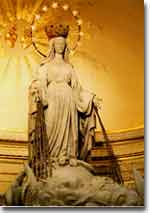
This 19th century statue of Our Lady of the Miraculous Medal stands above the main altar in the sanctuary at Rue du Bac in Paris.
You may ask why I have leaped 14 centuries from the Council of Ephesus in 431 to the apparition at the Rue du Bac in 1830. I choose Rue du Bac for three reasons: first, it can be representative of other apparitions because it shares significant common elements with them; secondly, the Miraculous Medal has million of devotees throughout the world; third, it has had a very prominent place in the heritage of our own Vincentian Family.
One must, of course, be very cautious about apparitions. Reports of these are abundant. In France alone, Mary was alleged to have appeared in at least 21 locations between 1803 and 1899; many of these appearances have long been forgotten. Between 1928 and 1971, there were 210 claims of apparitions at various places throughout the world. The Church's experience has taught us to be very slow about paying undue attention to such events. But some, like the devotions centered at Rue du Bac, Lourdes, and Fatima,[13] have received a form of official approval and encouragement.
With all apparitions, believers should be very aware of two basic principles:
- Only the Scriptures, as interpreted in and by the Church, are God's public revelation; apparitions do not add new revelation necessary for our salvation. The heart of
Christian faith always lies in listening to the word of God, as revealed in the Scriptures, and acting on it, as did the Virgin Mary.
- Apparitions, the messages they bear, and prayers evoked by them belong to the realm of private devotion. They are a way of concretizing and expressing our faith. As private devotion, the more closely related they are to the central mysteries of our faith, the more helpful they are.
Often, apparitions state, in popular form, a message that concretizes Christian faith or morals as rooted in the Scriptures. They say dramatically: be converted, seek peace, contemplate the suffering love of Jesus, pray faithfully and mightily, imitate Mary, the Mother of Jesus. Of course, all those messages are already stated clearly in the Scriptures. In that sense, apparitions are not necessary for our salvation. No one is bound in faith to believe in them. Their popularity waxes and wanes. But they occur repeatedly because the popular imagination needs to be captured and all of us need to be reminded.
St. Catherine Labouré's visions in 1830 gave popular expression and powerful impetus to the dogma of the Immaculate Conception which Pius IX proclaimed two decades later in 1854. Surely without Catherine Labouré Christians throughout the world would never have prayed so often: "O Mary, conceived without sin, pray for us who have recourse to thee." Rue du Bac continues to draw believers ─ millions of them annually in fact ─ to reflect on the Immaculate Conception of the Virgin Mary, on her graced union with the Lord, and to ask Mary, the first among the saints, to pray with us in our need.
The medal, moreover, has always had a special appeal for the poor, the humble. More than one billion medals were made even in St. Catherine's lifetime, spreading to the remotest corners of the world. The people themselves gave it the name "Miraculous Medal." Born in an era of rationalism, the medal proclaimed the need for symbols to express faith, love, commitment. Struck in an age that sought scientific explanations for everything, the medal proclaimed God's provident loving care for all human persons.[14] The symbols on the medal were, in fact, a graphic catechesis about God's love and concern for his people.
What does this fourth Marian face teach us? It reminds us that Mary is free from sin, the most perfectly redeemed of God's creatures. She is the first among the saints. And it encourages us, within the communion of saints, to unite our prayer with hers in our need, trusting deeply in God's provident love for us. In a special way, it is a symbol for the poor, evoking their trust that God listens, even if the world does not.[15] Apparitions like that of Our Lady of the Miraculous Medal remind us that God's loving concern needs to, and continues to, find popular human expression in the world, especially through the mystics and the saints.
The Black Madonna
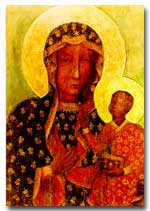
The famous icon, which arrived in Czestochowa in 1382, has a long, important history in Polish piety.
Of the thousand faces of Mary why is this one my final choice?
The reason is simple. Today Church documents talk again and again today about inculturation. It has been the theme of the general chapters of numerous missionary communities. Christian faith is very malleable and the Christian imagination is very creative. Consequently Marian devotion has been inculturated countless times in countless cultures. Recently I saw a painting of an Indonesian Virgin Mary at a seminary in Java. I have seen Chinese Virgins, Filipino Virgins, African Virgins. All have seen Our Lady of Guadalupe and perhaps many other Latin American Virgins.
There is something wonderfully paradoxical about all this. Intellectually, we know that Mary was a poor Jewish woman. She was not black nor did she have Chinese or Indian features. We know too of course that she did not wear the elaborate European robes in which Murillo and Lippo Lippi painted her. Her features were probably very much like those of Jewish or Palestinian women living in that area today; her clothes were those of the poor. We know all of that with our heads. But popular imagination shaped her to the features of the believing community. She is our mother, so the black has loved to see her black; the Indian has loved to see her Indian; the European, European; the Chinese, Chinese; the Mexican, Mexican. In fact, Octavio Paz once stated: "Our Lady of Guadalupe has been a sign in which each epoch and each Mexican has read his destiny."[16] Mexicans call her "la Morenita," a term of endearment for the dark Virgin whom they love so much.[17]
The "multi-cultural Mary" receives special inspiration from the words of the bride in the Song of Songs: "I am black and beautiful."[18] This theme flourished in Northern Africa and Ethiopia, as well as in Asia Minor; there are black Madonnas too in France, in Brazil, and in many other countries. The most famous "Black Madonna," the celebrated icon at Jasna Góra in Czestochowa has become a central symbol in Polish popular devotion. Ironically, the blackened face of the Virgin in that icon was the result of smoke, not of skin color, but its darkness has symbolized for Poles the suffering that Mary bore heroically, hoping against hope. Because of Mary's universal appeal, she has become a powerful force for liturgical and artistic inculturation,[19] taking on local dress and skin-color effortlessly.
What can we learn from this fifth face of the Virgin Mary? We can learn to be creative and sensitive to cultural differences. "The poor have the true religion," St. Vincent de Paul once wrote.[20] Their religious forms are much less heady than those of us theologians. Of course, popular religion runs the danger of abuse, but so does my theology. The poor sense spontaneously how important inculturation is. They recognize that the essential thing is not that Mary lived in the territory of Israel and that her skin color was like that of middle-easterners. The essential thing is that she was one of us (whether us means European or African or Filipino or Chinese), that she responded affirmatively and wholeheartedly to God's call, that God took hold of her life by being born of her flesh, and that she remained steadfast in faith through life's joys and sorrows. The Black Madonna and many other similar Madonnas make it easier for many to see Mary's story as applicable to any time, any place, or any culture.
I offer these five Marian faces as a way of reflecting on the rich, varied tradition surrounding the Virgin Mary. In conclusion, I say to the reader as Jesus said to the disciple whom he loved[21]: "Behold your mother." Behold her face, and let it speak to you.
Robert P. Maloney, C.M.
Footnotes
- ↑ Maria Chiara Stucchi, "La Bellezza e la Tenerezza di Maria in `Vita Consecrata'," Religiosi in Italia (# 300; May-June 1997) 81*-88*.
- ↑ George Tavard, The Thousand Faces of the Virgin Mary (Collegeville, Minnesota, 1996). Cf. also, Jaroslav Pelikan, Mary Through the Centuries (New Haven, Connecticut, 1996).
- ↑ Cf. Mk 6:3; Mt 13:55.
- ↑ Mk 3:31; Jn 2:1-12.
- ↑ Mk 3:21.
- ↑ Mk 3:31-35.
- ↑ Jn 19:25; Acts 1:14.
- ↑ For historical data about Mary, cf. John P. Meier, A Marginal Jew (New York: 1991) esp. 253ff; also, Raymond E. Brown, Karl P. Donfried, Joseph A. Fitzmyer, and John Reumann, eds., Mary in the New Testament: A Collaborative Assessment by Protestant and Roman Catholic Scholars (Philadelphia and New York: Fortress Press and Paulist Press, 1978), 28-29.
- ↑ Lk 2:19; 2:51.
- ↑ Lk 1:38.
- ↑ Lk 8:19-21.
- ↑ Lk 1:46-55.
- ↑ Pelikan, op.cit., lists ten apparitions as having received some form of ecclesiastical encouragement. Cf. pp. 178-179.
- ↑ John Prager, "María de Los Pobres, una relectura de la Medalla Milagrosa desde la perifería," CLAPVI XXIII, N° 96 (July-December 1997) 171-179.
- ↑ Cf. René Laurentin, Vie de Catherine Labouré (Desclée de Brouwer: Paris, 1980) and Catherine Labouré et la Médaille Miraculeuse 2. Procès de Catherine (Congrégation de la Mission, Filles de la Charité, Dessain et Tolra: Paris, 1979).
- ↑ Octavio Paz, as quoted in Jacque Lafaye, Quetzalcóatl and Guadalupe: The Formation of Mexican National Consciousness, 1531-1813 (Chicago: University of Chicago Press, 1976), xix.
- ↑ V. Elizondo, La Morenita: Evangelizadora de las Américas (St. Louis: Ligouri, 1981).
- ↑ Sg 1:5.
- ↑ Sally Cunneen, In Search of Mary (New York: Ballantine Books, 1996) 172ff.
- ↑ SV XI, 201.
- ↑ Jn 19:27.
_
